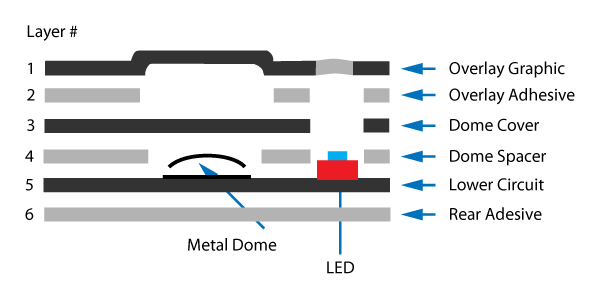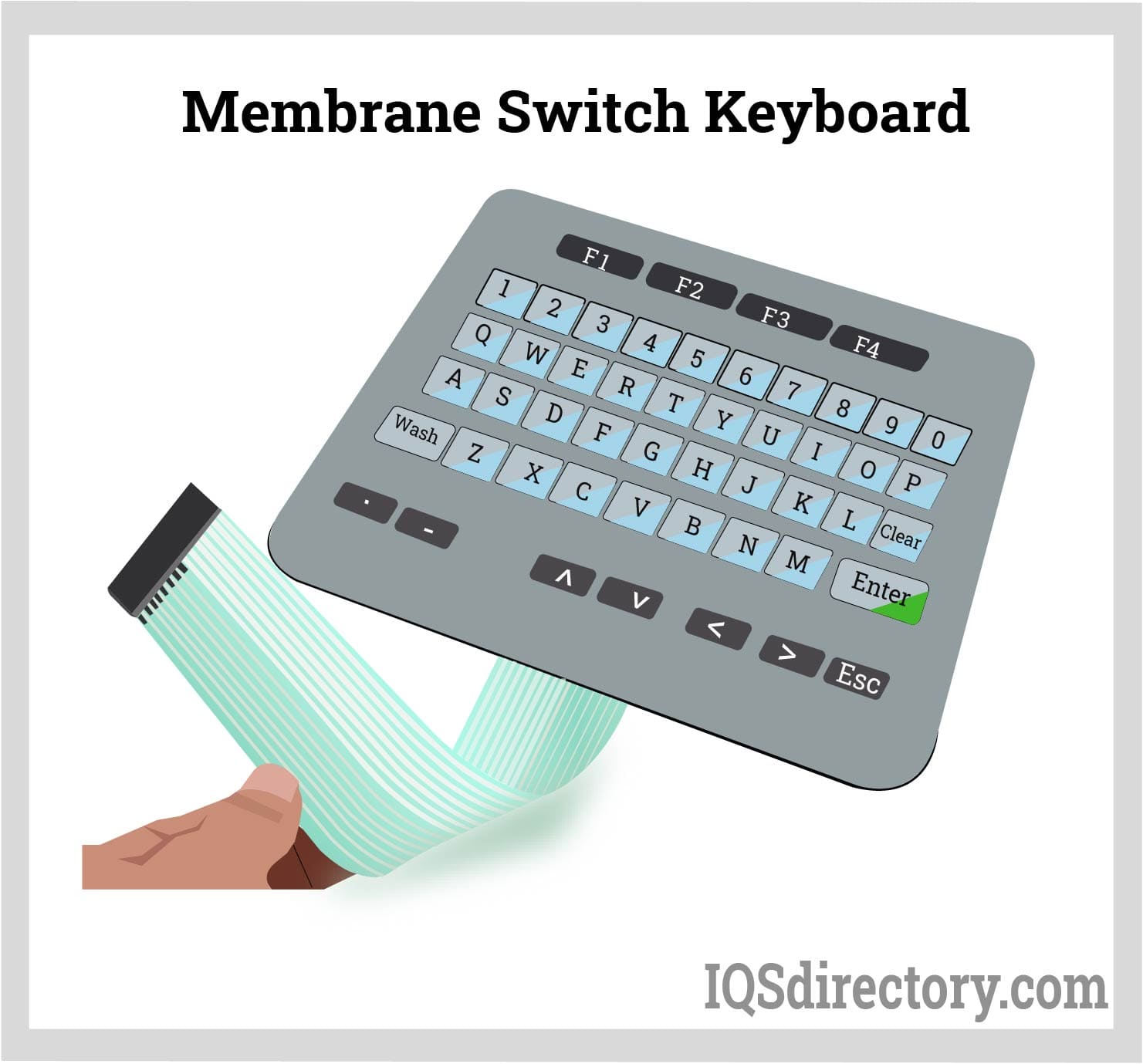Everything About Membrane layer Switch Over: A Comprehensive Overview for Beginners
Membrane layer buttons are necessary parts in modern-day electronics, using an one-of-a-kind interface for user interaction - membrane switch. Their split building and construction, including overlays and conductive traces, supplies capability and toughness. Unlike typical mechanical buttons, membrane layer switches provide a smooth layout and personalized alternatives. Comprehending their crucial functions and advantages can change item style. However, the details of their application and layout considerations require further exploration
What Is a Membrane layer Change?
A membrane switch is a sort of electric button that includes a versatile membrane layer layered over a published circuit board. This style permits a streamlined and portable user interface, frequently utilized in numerous electronic gadgets. Membrane layer buttons are commonly found in customer home appliances, medical tools, and industrial machinery because of their toughness and resistance to environmental factors.The construction typically includes multiple layers, such as graphic overlays and glue backing, which offer tactile responses and shield the circuitry below. The procedure of a membrane layer button is started when pressure is related to the surface area, completing an electric circuit.These buttons are valued for their convenience, enabling custom layouts and printed graphics that accommodate certain interface. Their inconspicuous nature minimizes area demands, making them perfect for applications where standard buttons may not fit. Overall, membrane layer buttons use a practical and aesthetic option for modern digital devices.
Key Components of Membrane Layer Switches
Membrane layer switches make up numerous crucial components that add to their performance and efficiency. The leading layer, called the overlay, supplies the customer interface and is frequently printed with graphics or symbols. Below the overlay exists a spacer layer, which separates the conductive aspects and prevents unintentional activation. The next crucial component is the graphic layer, which enhances visual appeals and assures the resilience of the design.Conductive traces, generally made from products like silver or carbon, are published on the circuit layer. When stress is related to the overlay, these traces enter into call, completing the circuit. Furthermore, a backing layer supplies structural assistance and can be made from products such as polyester or polycarbonate. Together, these elements develop a dependable, easy to use interface ideal for various applications, from home home appliances to commercial equipment. Understanding these aspects is important for any person interested in membrane switch technology.
Just How Membrane Layer Switches Over Work
Recognizing how membrane switches feature is essential for appreciating their extensive use in numerous devices. A membrane button runs with a collection of layers, including a graphic overlay, spacer, and a circuit layer. When stress is used to the overlay, it presses the spacer layer, permitting the circuit layer to make call and complete an electrical circuit. This action sends a signal to the tool, prompting a reaction, such as switching on a light or triggering a function.Membrane switches over can be developed with different attributes, consisting of responsive responses, backlighting, and personalized graphics, improving customer communication. Their building and construction enables a closed design, protecting the interior elements from dirt, wetness, and pollutants. This resilience makes them suitable for varied applications, from customer electronics to industrial devices. Overall, the simplicity and performance of membrane switches add to their appeal in modern technology.
Advantages of Membrane Layer Switches Mechanical Switches
While mechanical buttons have long been a staple in numerous devices, membrane switches over offer distinct advantages that make them increasingly appealing. One significant benefit is their slim account, permitting more portable layouts and higher adaptability in product advancement. Additionally, membrane layer changes attribute a consistent surface, which enhances visual allure and simplifies cleaning, making them appropriate for atmospheres where health is critical.Another benefit is their resistance to dirt and moisture. Unlike mechanical switches, which can be jeopardized by ecological elements, membrane layer buttons offer a covered interface that safeguards against impurities - membrane switch. Furthermore, membrane layer switches commonly have a longer lifespan as a result of fewer moving components, resulting in improved toughness and reliability.Cost-effectiveness is additionally a notable benefit, as membrane switches can be created in mass with reduced production expenses. These variables integrate to place membrane layer buttons as a practical alternative to traditional mechanical choices in different applications
Typical Applications of Membrane Switches
Membrane layer buttons are extensively made use of in different industries, especially in consumer electronic devices and commercial control panels. In consumer devices, they give a smooth, user-friendly interface, while in commercial settings, they enhance durability and functionality. Recognizing these applications highlights the adaptability and practicality of membrane layer buttons in modern innovation.
Consumer Electronics Instruments
As consumer electronics remain to evolve, membrane layer switches have actually ended up being a popular selection for a range of tools because of their versatility and streamlined design. These buttons are commonly located in mobile phones, tablet computers, and push-button controls, where area is restricted and aesthetic appeals issue. Their low profile and personalized styles permit manufacturers to develop user-friendly interfaces that boost the total user experience. Additionally, membrane switches are often made use of in appliances such as microwaves and coffee machine, offering instinctive control options while withstanding wetness and dirt. The resilience and integrity of membrane switches over make them ideal for everyday consumer products, ensuring longevity and consistent performance. Generally, their integration in consumer electronics reflects a mix of functionality and contemporary style.
Industrial Control Panels
The applications of membrane changes prolong past consumer electronics, discovering substantial usage in commercial control board. These switches are preferred for their durability and resistance to rough settings, making them optimal for producing and process control settings. They provide a trusted user interface for drivers to manage machinery, monitor procedures, and adjust setups. Membrane layer buttons can be customized to suit specific operational needs, including attributes like backlighting and tactile feedback, boosting individual experience. Their inconspicuous layout permits integration into numerous devices, while their capacity to endure spills, dirt, and severe temperature levels assurances long life. Generally, membrane layer buttons add to effective and secure operation in commercial applications, demonstrating their adaptability and effectiveness popular atmospheres.
Factors To Consider for Designing Membrane Changes
When making membrane buttons, selecting the best materials is important to guarantee resilience and performance. Furthermore, recognizing layer setup techniques can significantly impact the button's efficiency and user experience. These factors to consider play an important role in creating efficient and dependable membrane layer button styles.
Material Selection Importance
Product option plays a crucial duty in the layout and capability click here to read of membrane layer buttons. The chosen materials directly affect the button's longevity, tactile response, and overall aesthetic. Trick considerations consist of the substrate, which have to provide structural honesty while enabling adaptability, and the visuals overlay, which requires to be resistant to use and environmental factors. Conductive materials need to guarantee trustworthy electrical performance, while adhesives must supply solid bonding without endangering the button's operation. Additionally, compatibility with making procedures and end-user atmospheres is important; products need to stand up to varying temperatures, moisture look what i found levels, and chemical direct exposure. Eventually, proper product option not just enhances the membrane layer button's efficiency yet also contributes to its long life and individual fulfillment, making it an important element of the style procedure.

Layer Configuration Methods

Regularly Asked Concerns
For How Long Do Membrane Layer Switches Over Normally Last?
Membrane switches usually have a life expectancy of 1 to 5 million cycles, depending upon usage and environmental problems. Factors such as style high quality and operating frequency considerably affect their resilience and total efficiency long life.

Can Membrane Switches Be Personalized for Details Styles?
Membrane buttons can undoubtedly be personalized to suit certain designs, permitting for varied forms, colors, and functionalities. This versatility allows suppliers to tailor these buttons to fulfill one-of-a-kind aesthetic and operational demands successfully.
What Materials Are Made Use Of in Membrane Switch Over Construction?
Membrane buttons are normally constructed utilizing products such as polyester, polycarbonate, and adhesive layers. These products offer durability, versatility, and resistance to environmental aspects, making sure the switches work effectively in various applications and conditions.
Are Membrane Layer Changes Resistant or water resistant to Dampness?
Membrane layer switches can be made to be moisture-resistant, making use of specialized coverings and materials. However, their water resistant abilities rely on building and construction top quality and specific applications, making it necessary to examine needs for excellent efficiency in numerous settings.
Exactly How Are Membrane Changes Repaired if Damaged?
Fixing broken membrane switches generally involves replacing the influenced layer or circuit. Specialists may also use conductive sticky or utilize specialized repair service packages, making sure performance is restored without full substitute of the whole button setting up. Unlike typical mechanical buttons, membrane buttons provide a smooth design and personalized choices. A membrane button is a kind of electrical switch that consists of an adaptable membrane layer layered over a published circuit board. The operation of a membrane layer switch is launched when pressure is used to the surface area, completing an electric circuit.These switches are valued for their versatility, allowing custom-made layouts and printed graphics that cater to details individual interfaces. While mechanical switches have long been a staple in several gadgets, membrane layer changes deal unique advantages that make them significantly appealing. Membrane buttons usually have a longer lifespan due to fewer relocating components, resulting in enhanced durability and reliability.Cost-effectiveness is likewise a notable advantage, as membrane buttons can be produced in bulk with reduced manufacturing expenses.
Comments on “Designing intuitive user interfaces with membrane switch”